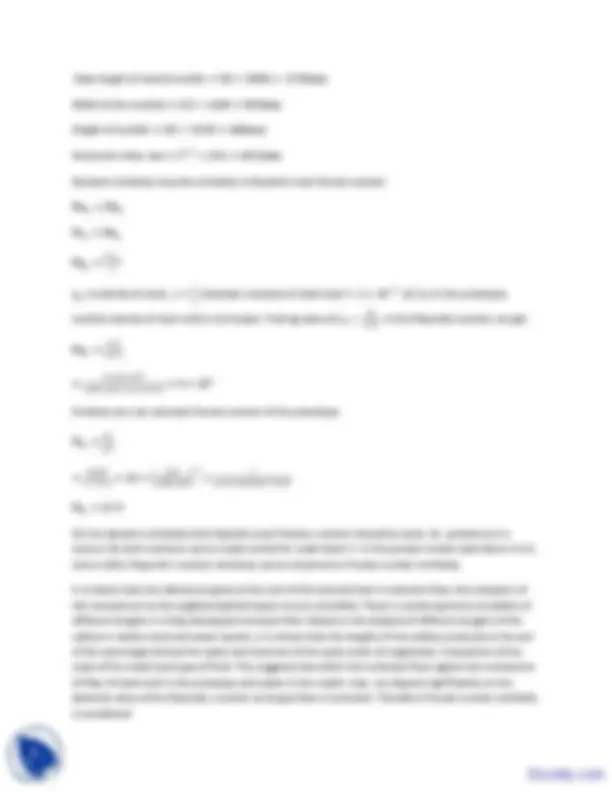




Study with the several resources on Docsity

Earn points by helping other students or get them with a premium plan


Prepare for your exams
Study with the several resources on Docsity

Earn points to download
Earn points by helping other students or get them with a premium plan
Community
Ask the community for help and clear up your study doubts
Discover the best universities in your country according to Docsity users
Free resources
Download our free guides on studying techniques, anxiety management strategies, and thesis advice from Docsity tutors
The major points which I found very informative are:Illustration of Physical Modeling, Tapping of Molten Steel, Gas Stirred Ladle, Tundish Model, Water Modelling, Volumetric Flow Rate, Time of Tapping, Froude Number of Prototype, Model Scale Factor
Typology: Study notes
1 / 4

This page cannot be seen from the preview
Don't miss anything!



Lecture 39: illustration of physical modeling
Contents
Tapping of molten steel
Gas stirred ladle
Tundish model
Key words: Physical modeling, water modelling
Tapping of molten steel
Let us design a 0.2- scale physical model to simulate the fluid flow behavior for tapping of steel in the
ladle. Molten steel is plunged from a height of 4.5m. Molten steel enters at velocity 12m/s velocity. The
volume flow rate is 0. 12 m
3
s
. The time required to fill the ladle of volume 40 m
3
is 8 minutes. Viscosity
of steel = 7 × 10
− 3
kg
m.s
and density is 7000
kg
m
3
Diameter of the model ladle d m
= 0. 2 × 4. 5 = 0. 9 m
Volume V
m
= λ
3
p
3
× 40 = 0. 32 m 3
Volumetric flow rate Q
m
= λ
5 ⁄ 2
p
− 3
m
3
s
In the physical model, water will be used to simulate the steel. We have to find velocity of the water in
the model to perform experiments. Dynamic similarity is required.
Re p
ρ u L p
μ
7000 × 10 × 4. 5
7
Fr p
u
2
g L
p
10 × 10
A very large value of Reynold’s number in the prototype indicates that flow of steel melt is dominated
by the inertial forces rather than viscous forces. Inertial force is also embedded in the Froude number
hence Froude number similarity will be sufficient to find velocity of water in the model.
U m
U p
L m
L p
m
= 5. 34 m/s
The time of tapping in the model can be derived from
L m
t
m
t
p
L
p
= λ
t m
t p
L m
L p
× λ −
= λ
∴ t m
= t
p
= 3. 6 minutes
Gas stirred ladle
Design a physical model of an industrial gas stirred ladle with an elliptical shape. Internal diameter of
the ladle is 2.282m maximum and 2.082m minimum. Molten steel height is 2.46m and volume is 9. 4 m
3
Gas is injected at 70 Nl/min through the porous plug fitted at the bottom of the ladle. The scale of the
physical model should be 1 / 3. Bath temperature is 1600 ℃.
The equations given in lecture 38 could be used to design the model. This is for your exercise.
Tundish model
Fluid flow in the tundish has been investigated thoroughly. Several investigators including the present
author have studied behavior of steel melt flowing in a single and multi strand tundish. In the original
installation of the continuous casting machine, role of tundish was to act as a distributor of molten steel
to different molds at constant speed. It has soon been realized that tundish can be used to float
inclusions or to add alloying elements during the process of continuous casting. To full fill the above
objective it became necessary to modify the existing tundish design. Physical model of a tundish of
single and multi strand casters has been designed by several investigators to study the fliuid flow
behavior in the tundish
Design a physical model of a single strand slab caster tundish. The base length of the tundish is 3450mm,
width 1100mm and height 1320mm. Tundish is rectangular shaped with slopping walls. Submerged ladle
shroud diameter is 78mm. Volumetric flow rate of steel in the tundish is 224 l/min. Scale of physical
model = 0. 5.
Now we have to design a tundish. One must keep in mind the future modifications that would be
required. We may require to modify the flow of fluid in the tundish. We have to make previsions to
insert flow modifiers like dam and weir etc.
The dimensions of the model tundish are 1725 mm × 550 mm × 600 mm. The tundish is rectangular in
cross section with slopping side walls. The tundish may be provided with the grooves to insert dams and
weirs etc. A submerged stream is poured from the model ladle to the tundish.
Physical model of the tundish is designed to study the fluid flow behavior in terms of flow pattern and
residence time distribution.
Solution: water will be used as an analogue of steel.
Following Froude number similarity model submerged ladle shroud diameter can be determined.
m
16 ×Q
̇
2
π
2
×g
1 ⁄ 5
≈ 38 mm